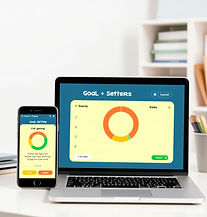Goal Setters in a
New Culture of Learning
Introduction
When we talk about meaningful learning, we are really talking about creating spaces where
students feel empowered, engaged, and inspired. That is the heart of what I am aiming for with
my innovation proposal—to use technology not just for convenience, but to build a significant
learning environment (SLE) where students can truly thrive.
Why This Matters
Right now, one of the biggest challenges we face is that students often do not have a
clear, consistent way to set and track their goals. Without that structure, it is easy for
motivation to slip and for students to lose sight of their progress. That is why I am proposing
a digital goal-tracking system—something that is simple, accessible, and designed to help
students take ownership of their learning journey. This is not just about checking boxes.
It is about helping students see their growth, reflect on their efforts, and build confidence in their ability to succeed (Dweck, 2006).
What This Solves
This approach directly addresses a few key issues:
- Lack of structure: Students will have a clear, daily system to guide their efforts.
- Low motivation: Seeing progress in real time can be incredibly motivating (Zimmerman, 2002).
- Limited student agency: This gives students a voice and a choice in their learning.
By embedding this system into a broader learning environment, we’re not just adding tech—we are reshaping how students experience school.
Bringing in Big Ideas: A New Culture of Learning
In A New Culture of Learning by Thomas and Brown (2011), the authors talk about
how learning thrives in environments that encourage play, inquiry, and imagination. That is exactly what I want to foster. When students set their own goals and track their progress, they are not just learning content—they are learning how to learn. They also emphasize the importance of social learning. I see opportunities to build in peer collaboration, where students can share goals, celebrate wins, and support each other. That kind of community can be powerful.
Challenges I Expect—and How I’ll Tackle Them
Let us be real: change is hard. Here are a few bumps I anticipate and how I plan to smooth them out:
- Resistance to new tech: I will offer hands-on training and highlight success stories to build buy-in.
- Access issues: We will work to ensure all students have the devices and internet access they need.
- Over-reliance on the app: I will make sure this tool complements—not replaces—human connection and mentorship.
How This Impacts Our School Culture
This is not just a tech upgrade—it is a mindset shift. We are moving toward a culture where students are active participants in their learning. Teachers become coaches and guides, and data becomes a tool for growth, not judgment (Hattie, 2009).
Encouraging Big-Picture Thinking
To go beyond just holistic learning and encourage holistic thinking, I will:
- Integrate cross-curricular projects tied to student goals.
- Encourage reflective practices like journaling and goal reviews.
This helps students connect the dots between school, life, and their future.
Shaping My Learning Philosophy
This approach reflects my belief that learning should be personal, purposeful, and empowering. It is rooted in constructivist ideas—students build knowledge through experience—and it aligns with what thinkers like Fink (2013), Fullan (2013), and Pink (2009) say about motivation, change, and meaningful learning.
References
Dweck, C. S. (2006). Mindset: The new psychology of success. Random House.
Fink, L. D. (2013). Creating significant learning experiences: An integrated approach to designing college courses (2nd ed.).
Jossey-Bass.
Fullan, M. (2013). The new meaning of educational change (4th ed.). Teachers College Press.
Hattie, J. (2009). Visible learning: A synthesis of over 800 meta-analysis relating to achievement. Routledge.
Pink, D. H. (2009). Drive: The surprising truth about what motivates us. Riverhead Books.
Thomas, D., & Brown, J. S. (2011). A new culture of learning: Cultivating the imagination for a world of constant change. CreateSpace.
Zimmerman, B. J. (2002). Becoming a self-regulated learner: An overview. Theory into Practice, 41(2), 64–70.


